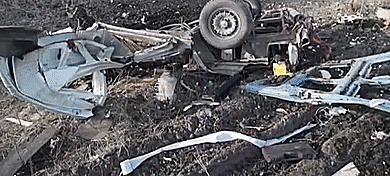Hidden Danger Across Eastern Ukraine
The ongoing threat of mines and unexploded ordnances to civilians and soldiers
Hidden Danger Across Eastern Ukraine

BANNER: Source: Wikimedia
On June 12, two civilians were injured when their truck hit an anti-tank mine in Bairak, near non-government-controlled Horlivka, Donetsk Oblast. A woman who was injured in the incident stated that they frequently use the road where her vehicle hit the mine. After the incident, an emergency service employee in Horlivka told the Organization for Security and Co-operation in Europe (OSCE) Special Monitoring Mission (SMM) to Ukraine that six anti-tank mines were found near the site. The area was later cleared by a controlled explosion.
Mines and unexploded ordnances (UXO) have presented serious hazards, threats, and security impediments to persons on the ground since the beginning of the conflict. Explosive remnants of war (ERW) pollute the conflict area, limit agricultural work, and pose serious security and economic hazards. Farmers have unearthed UXO when they plough fields, large calibre UXO shells have been found in residential gardens near small children, and passenger buses have driven over landmines, all causing civilian casualties.
The OSCE SMM, civilians, and armed forces continue to face hazardous conditions on both sides of the front line due to the presence of mines and UXO. The OSCE Secretariat and Project Co-ordinator in Ukraine (PCU) began assistance with a humanitarian mine-action program aimed at training and equipping demining agencies and creating a digital map of cleared and active hazard areas. The International Committee of the Red Cross (ICRC) reported at least 250 people have been killed and 470 injured by ERW since the beginning of the conflict. The HALO Trust found an average of fifty casualties per month from mines in Ukraine, and began demining work in government-controlled areas in 2016. NATO has also assisted in the demining process, including assistance with subsurface radar technology and training.
In a joint report, the Geneva International Centre for Humanitarian Demining (GICHD) and the Stockholm International Peace Research Institute (SIPRI) found Ukraine to have the highest number of anti-vehicle mine incidents in 2016. The report states that mines caused 101 casualties and had “detrimental socio-economic effects, preventing people from using agricultural land for crops and livestock, which are the main means of subsistence. They were also an obstacle to the repair of infrastructure, such as water and gas supply, and limited the implementation of the Minsk Agreements…”

After an OSCE SMM monitor was killed in a likely mine accident, Deputy Chief Monitor of the OSCE SMM Alexander Hug called out the Joint Centre for Control and Co-ordination (JCCC) for its failure to coordinate mine clearance stipulated in the September 19, 2014 Memorandum and the March 3, 2016 Trilateral Contact Group (TCG) Decision on Mine Action.

The OSCE SMM reports sighting of new mine hazard signs despite agreements to demine; signs prevent monitors from proceeding in the area due to security concerns. The OSCE SMM is impeded by mines or UXO in their daily work, and continues to be critical of the JCCC’s failure to facilitate safe access for monitors and lack of demining and de-escalation.

